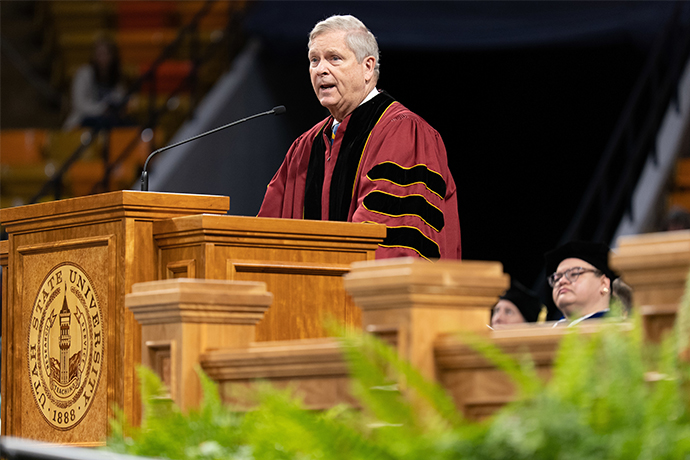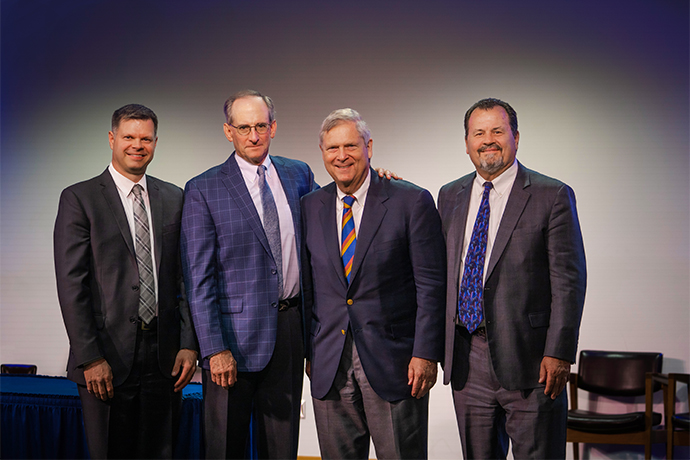U.S. Secretary of Agriculture Tom Vilsack
By Lynnette Harris | March 22, 2023

When Tom Vilsack urged Utah State University’s class of 2022 to look for opportunities for public service, it came from a place of personal experience and commitment. Vilsack is currently serving his second appointment as U.S. Secretary of Agriculture, and is a former mayor, member of the Iowa Senate, and was the state’s 40th governor. His definition of public service is not restricted to political office or work in government, though he did urge graduates to consider working in government agencies.
“What is most important in my view, is that you adopt a mentality of public service,” Vilsack said. “This means that whatever you do, you think about how that single act, or the summation of all those acts, may prove beneficial to the greater good. From the small daily acts to the larger life decisions you will face, look for ways to serve. If we all take on this mentality together, we can lift the collective tide in our country and leave this world a much better place than we found it.”
Vilsack noted that he had been invited to speak about resiliency and that it seemed a good topic for a group of new college graduates who persevered through a pandemic and COVID variants, shifted quickly to all online courses, and who are emerging from college at a time marked by “inflation, supply chain challenges, climate change, and the unprovoked invasion of a free and democratic nation.”
“True resilience, whether in a person, a community, or a nation requires a belief and a faith in something better and the confidence and capacity to make it happen,” Vilsack said. “Your generation has the capacity to make America stronger and more resilient, through the experiences, knowledge, and challenges of growing up in this time of great disruption.”
Framing his invitation to public service, Vilsack pointed out that there are a growing number of public service opportunities at every level of government that enable people to contribute to a more resilient America. At USDA, just 7% of the workforce is under the age of 35 and more than 50% is at or near retirement and other federal agencies have similar demographics. In meeting with CAAS students following commencement, Vilsack pointed out that the coming wave of retirements means great opportunities for rapid career advancement for young professionals now and in the next several years.
He noted many of the kinds of important work new graduates can be part of as they build careers and said the generation of most of the graduates has to be smarter and faster than any previous generation to sustainably grow crops, make products, transport goods, and power homes and businesses. His hope is for people to become community builders.
“During this nation’s history we have faced widespread disruptions in becoming a nation, and one nation,” he said. “Surviving a civil war. Emerging stronger from an economic depression and saving the world from unimaginable evil. In each case, we discovered the importance, significance, and power of acting together in community to confront the challenge. We again face a time of disruption, but this time we do so as a divided nation. What President Lincoln said so long ago is still true today, ‘A house divided against itself cannot stand.’”
Meeting after commencement with CAAS graduates and guests, Vilsack discussed some challenges and opportunities that working in agriculture presents now and that are critical to the country’s future. Here are some of the issues he addressed.
When you talk about agriculture, talk about food. Too many consumers still don’t connect agriculture with being the source of their food and clothing.
Building more robust local food systems that include growers and processors is important, as is putting more resources behind small and mid-sized processors.
He noted that COVID-caused shutdowns of processing facilities pointed out that the food production system the U.S. currently has is highly concentrated, highly efficient, highly productive, but not resilient or flexible. Regional food systems of producers and more local/regional small and mid-sized processing facilities will mean food is consumed closer to its sources. Vilsack added that regional food hubs will keep more money in rural communities and producers should receive help to better understand changing markets and pricing so they work from knowing the true market value of their products.
Nutrition security is vital, not just food security. People can be fed, but still have nutrition deficits. More money was spent in the U.S. last year to treat diabetes and its attendant health problems than there is in the USDA’s budget. Education about simple, wiser food choices is vital. SNAP benefits could incentivize healthier food choices by charging less for them.
Climate adaptation is imperative and could present opportunities for farmers and ranchers to earn money for natural resource conservation work. Carbon credits for growing certain crops may be a part of that effort.
With big challenges ahead, Vilsack said, “I’m not interested in the status quo. We need bright, creative enthusiastic people who understand what farmers and ranchers contribute to the world.”
Lynnette Harris
lynnette.harris@usu.edu
